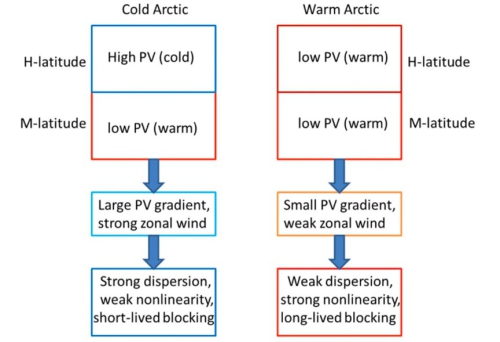PV Gradient Identified as Indicator of Atmospheric Blocking Change Linked to Arctic Warming
Date:2018-08-22
In the recent two decades, the impact of Arctic warming on midlatitude atmospheric circulation and cold extremes has become an important research topic because of accelerated Arctic warming. Winter Ural blocking (UB) have been recognized to play an important role in winter Eurasian cooling, because it transports cold air from high to middle latitudes and thus affects weather and climate over Eurasia. However, it is unclear what physical processes dominate the influence of the Arctic warming in Barents-Kara seas (BKS) on the UB.
Recently, Prof. LUO Dehai and his Ph.D. student CHEN Xiaodan from the Institute of Atmospheric Physics at Chinese Academy of Sciences through a cooperation with Prof. Aiguo Dai from State University of New York and Prof. Ian Simmonds from University of Melbourne, have revealed the physical process of how the winter warming in the Barents-Kara Seas (BKS) changes the duration of the UB events and established their linkage by inducing a key physical quantity: Meridional potential vorticity (PV) gradient.
Prof. Luo found from his nonlinear multi-scale interaction model that the nonlinear behavior of the blocking system is closely related to changes in the energy dispersion and nonlinearity strength. The energy dispersion is proportional to meridional PV gradient, whereas the nonlinearity strength is inversely proportional to the PV gradient. When the meridional PV gradient is small, the blocking is weakly dispersive and has a strong nonlinearity. In this case, blocking can maintain itself for longer lifetime and has large amplitude. In contrast, the large PV meridional gradient leads to the blocking system having strong dispersion and weak nonlinearity. Thus, the blocking is short-lived.
"The meridional PV gradient becomes different under Arctic warming background. The Arctic warming tends to produce a trend toward the PV homogenization with a small PV gradient over Eurasia. As a result, the energy dispersion is weak and the nonlinearity is strong so that the UB does not readily disperse its energy and hence can maintain its long lifetime," said Prof. Luo. These results provide new perspectives of how the mid-latitude atmospheric circulations such as blocking are linked to Arctic warming associated with sea-ice loss.

Figure 1. Schematic diagram of the Arctic warming in BKS affecting the lifetime of UB, where the M-latitude (H-latitude) denotes the middle (high) latitude region, and the PV gradient represents PV meridional gradient. (Image by LUO Dehai)
A schematic diagram explanation can be summarized in Fig. 1. The mid-latitude Eurasian region has a low PV and the high latitude has a high PV when the Arctic (such as BKS) is cold and the midlatitude continent is warm. Correspondingly, the meridional PV gradient is large and the westerly wind is strong. For this case the UB has strong energy dispersion and weak nonlinearity and then has a short lifetime. As a result, Eurasian cooling is hardly seen. When the Arctic is warm, both the meridional PV gradient and mid-latitude westerly winds are small. Then, the UB is more persistent due to weak energy dispersion and strong nonlinearity. For this case, strong cold extremes can be seen in East Asia.
Reference:
Luo, D., X. Chen, A. Dai, and I. Simmonds, 2018: Changes in Atmospheric Blocking Circulations Linked with Winter Arctic Warming: A New Perspective. J. Climate, 31,7661–7678, https://doi.org/10.1175/JCLI-D-18-0040.1
Contact: LIN Zheng, jennylin@mail.iap.ac.cn
